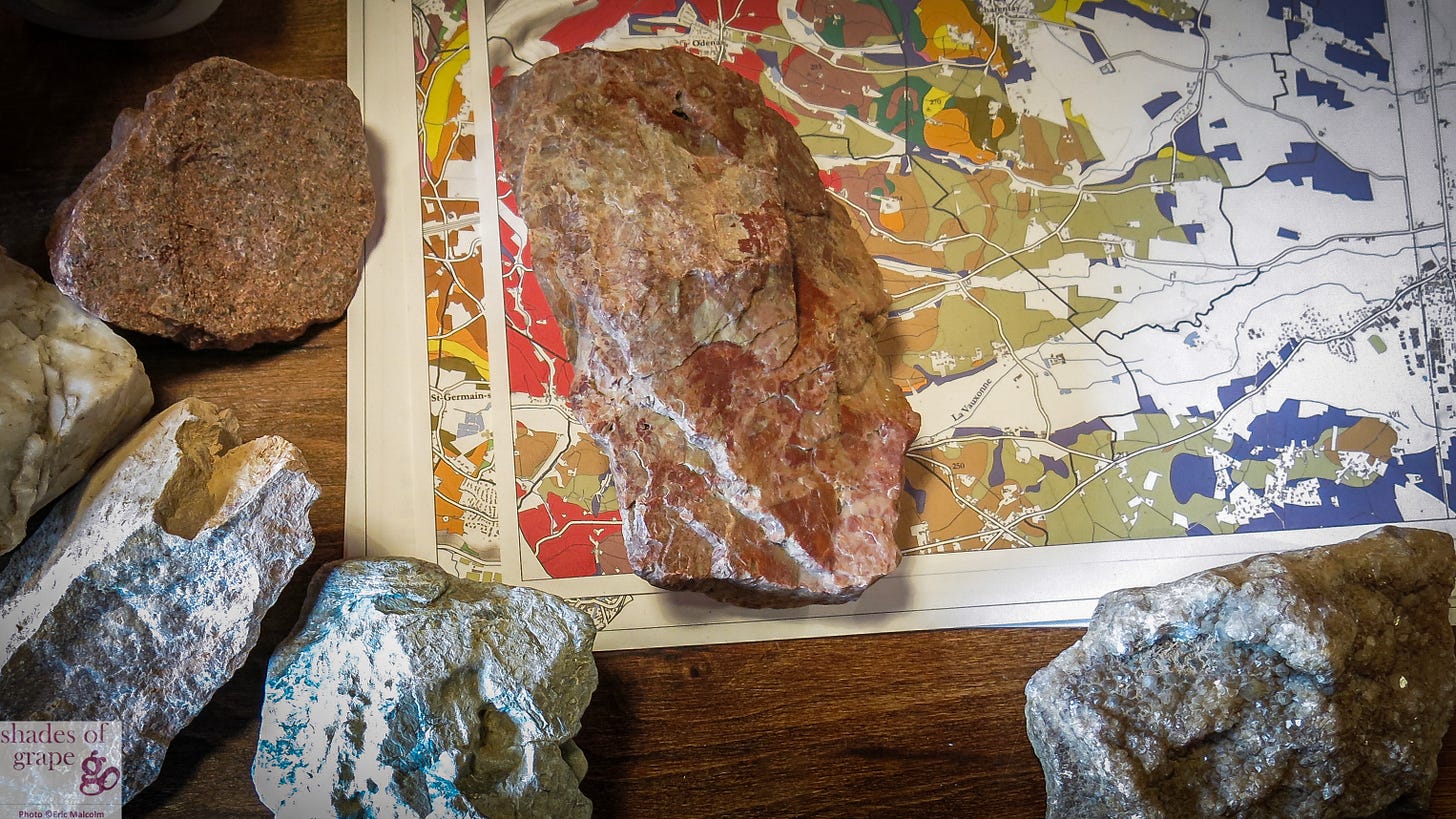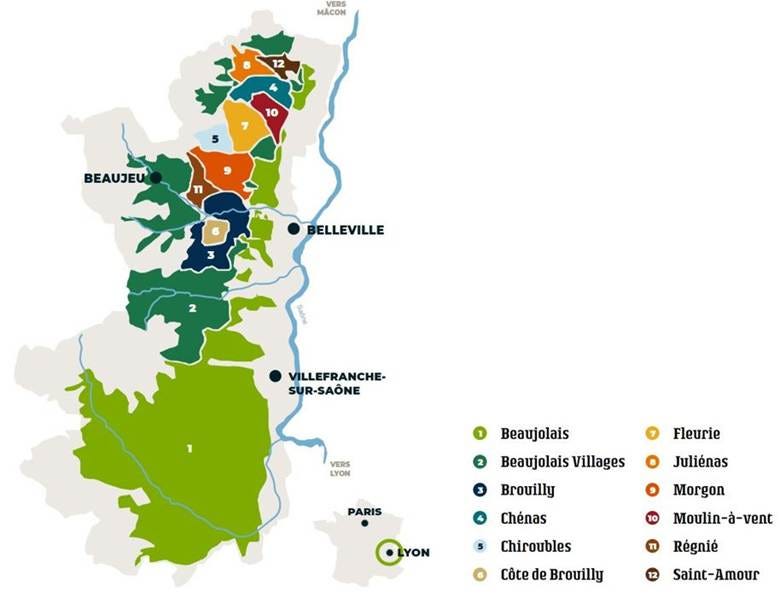Once Banished - Not All Beaujolais Is Created Equal (Here’s Why)
- breaking down the beaujolais crus
I love helping people discover wines they love — if you're in Alberta, let's connect! Would you like us to deliver wines to Edmonton? Please reach out!
Thanks to all the paid subscribers for their support! This funding helps cover the costs involved in creating these weekly articles!
Appreciate my wine recommendations? Enjoy my personal wine curation service? Consider upgrading to a paid subscription! Help me continue sharing the world of wine with you.
You may remember my post featuring the Beaujolais Villages wine from Mary Taylor where I explain how Beaujolais has many different styles.
Made from the Gamay grape, right?
Yes, reds from the Beaujolais region are 100% Gamay.
Beaujolais is just south of Burgundy, in eastern France. In fact, Beaujolais is considered part of greater Burgundy. Burgundy used to grow Gamay until Philip the Bold banned it …
Rude.
Today we elaborate on the Beaujolais wine region and its 10 crus.
Okay – stop right there …please define cru
According to the Oxford Companion to Wine, the term “cru”, which means “growth” in English, refers to vineyards that are part of a sub-region that are officially considered superior quality than the rest of the wine region.
Here they are, numbered 3 to 12 on the map below.
Brouilly
Chénas
Chiroubles
Côte de Brouilly
Fleurie
Juliénas
Morgon
Moulin-à-vent
Régnié
Saint-Amour
What distinguishes the Beaujolais crus from the Beaujolais and Beaujolais-Villages sub-regions is the soil. The crus’ parent rock is composed of granite, schist, and sandstone. The differences in the parent rock composition as well as the topography, elevation, and exposure to the sun, is what sets the sub-regions of Beaujolais wines apart.

That doesn’t make sense to me.
It boils down to ripeness. The sites that are sunnier, have warmer air temperature, and warmer soils will produce wines that are more intense in flavor and aromas.
And yet they are so close to one another!
Exactly.
The crus with clear reputations are Brouilly, Chiroubles, Fleurie, Moulin-à-Vent, and Morgon.
Brouilly & Chiroubles produce the lighter and fragrant style, while Moulin-à-Vent and Morgon are more powerful and consequently are capable of ageing.
You missed one, sloppy.
That is because Fleurie swings both ways (hee hee). In Fleurie’s southern portion the soil contains more sand, so the wines are lighter and more fragrant.
Today’s featured wine is from Fleurie and has this style.
Like Brouilly & Chiroubles.
Exactly. And this is the overall reputation of the Fleurie cru. So, if you don’t know any better, assume that it will be the style in the bottle.
I sense a but coming.
Towards the north of Fleurie, as it approaches Moulin-à-Vent, where more clay is present, the wines will have more body.
Is the cru named “Fleurie” because the wines tend to have floral aromas? Fleur is flowers in French, isn’t it?
That would be logical … but there is a legend!
Love the legends.
Legend says a Roman Legionnaire named Florus made his home in the hills overlooking the vines. Or was it a Roman general called Floricum?
Both are possible … that is the thing with legends.
Exactly, no records exist either way. Regardless the hill was named Montagne de Fleurie after one of them …
And hence the cru’s name!
There is something special about this hill! I am not sure what it is, but I felt it. Perhaps it’s the charming chapel of the Madonna (La Madone) which has a statue of the Virgin Mary on the top. The chapel is said to have been built in 1866 after pleas to have the Virgin help fight vine disease.
Ninety percent of Fleurie is composed of pink granite. Decomposed granite to be precise for the geologist among our readers.
You said that granite provided more body due to more ripeness from the warmer soil – granite would provide warmth. Yet, Fleurie is lighter. That is confusing to me.
Yes, Fleurie is lighter compared to other crus.
Other factors also come into play. Let’s talk altitude. Fleurie is at one of the highest cru altitude at 340 m. This results in wines with relatively higher acidity.
Are you saying that higher acidity means lower body?
Yes.
In my Valpolicella article, I discuss what increases body, the biggest impact being alcohol. Acidity does the opposite by decreasing the body.
Okay, so I was being too linear, what impacts these wines is multi-variate.
Precisely!
It is now time to let go of all the analysis and remember that wine is meant to be enjoyed!
So, let’s go enjoy!
Enjoying my recommendations? Consider upgrading to a paid subscription.
Albert Bichot ‘La Madone’ Fleurie 2023 from Beaujolais, France
Style: Fruit driven medium body red wine
Varieties: 100% Gamay
This bright, fruit-driven wine has inviting floral notes, red currant, strawberry, just ripe raspberry, red plum, red cherry, and a hint of strawberry compote. It has the additional complexity of baking spice, earth, and a hint of vanilla and milk chocolate. The tannins are moderate and the intensity is moderately high.
Best pairings: Grilled or roasted poultry, Light seasoned veal or pork dishes, Baked salmon, Leek & bacon quiche, Macaroni gratin, and Medium cheese: Havarti or Semi-soft goat cheese.
Serving Temperature: 12-14 degrees Celsius
Serving Tips: Pour into a decanter and serve immediately
Price: ~$37 Cdn
If you're in Alberta and want a one-on-one wine curation experience, please reach out! I am also considering delivering our wines to Edmonton!
A huge thank you to my paid subscribers—your support helps cover the costs of creating these weekly articles.
Love my wine recommendations? Enjoy my personal wine curation service? If you find value in my writing, consider upgrading to a paid subscription to help me keep sharing the world of wine with you!
I have compiled all my wine recommendations in one place. I will do my best to keep this up to date. I also include the link(s) to the article in which the wine was featured.
Like what you are reading? Click on the ❤ to let me know it resonated with you!
SOURCES:
Fleurie. Beaujolais. (2025, March 20). https://www.beaujolais.com/en/appellation/fleurie/
Fleurie. Vins du Beaujolais. (n.d.). https://www.vins-du-beaujolais.com/en/appellation/fleurie-3/
Harding, J. and Robinson, J. (2023) The oxford companion to wine. Oxford, United Kingdom: Oxford University Press.
MacNeil, K. (2022) The wine bible. New York, NY: Workman Publishing.
Mullen, T. (2020, February 17). Flavorful fleurie wines of France provide affordable, excellent quality. Forbes. https://www.forbes.com/sites/tmullen/2020/02/17/flavorful-fleurie-wines-are-great-value/
Wine & Spirit Education Trust (2021) D3: Wines of the World - An accompaniment to the WSET Level 4 Diploma in Wines. Version 1.2. London: Wine & Spirit Education Trust.






Love this - so funny. We will head to this region in June so it's god to be armed :) x
Love Beaujolais as a region, a wine and a concept. Presented a staff training on it yesterday and it struck me what a useful explorational prop it is for wine in general: A great entry point with recognisable, easy-going, chillable reds with no aggressive qualities that then allow you to dig right down and climb right up. A universal beginning with an interesting, singular arc. Go Beaujolais! Go wine!